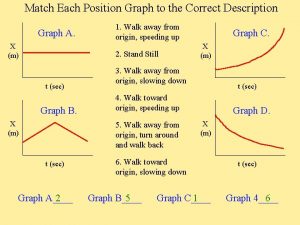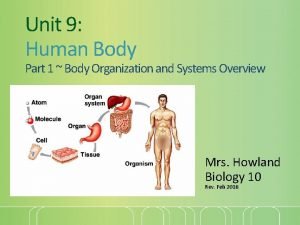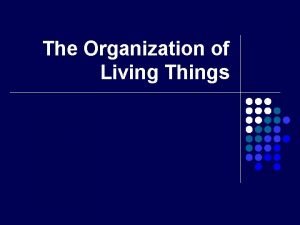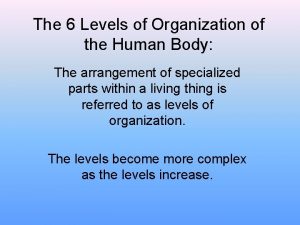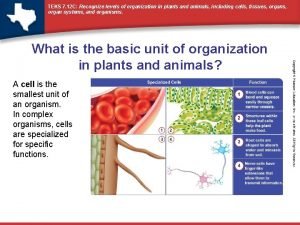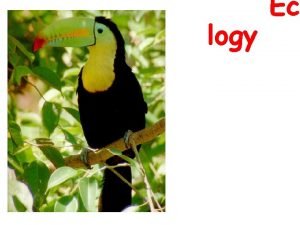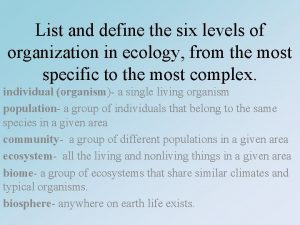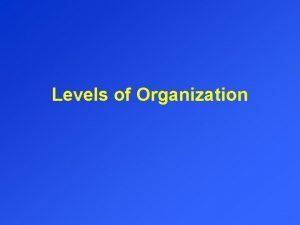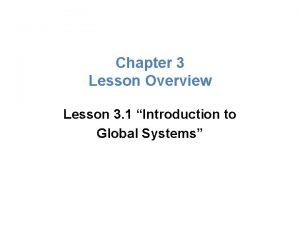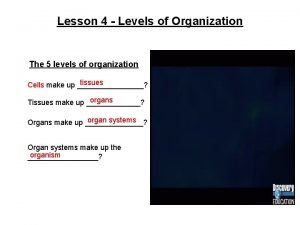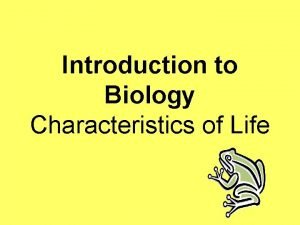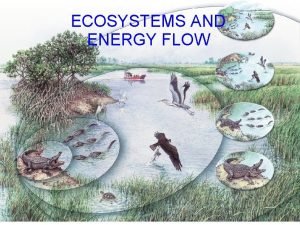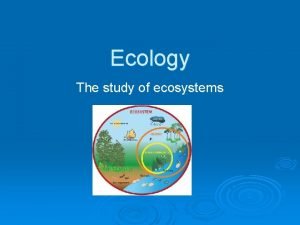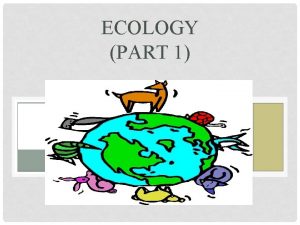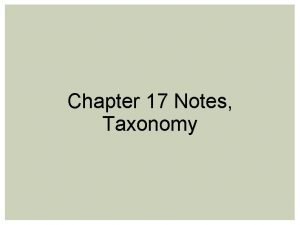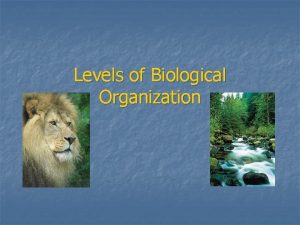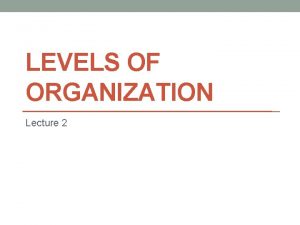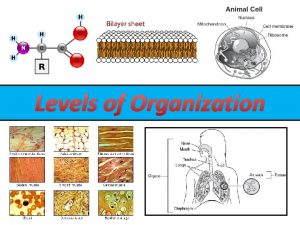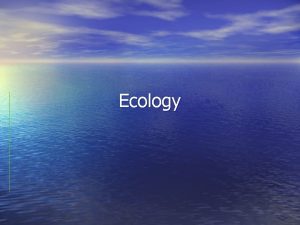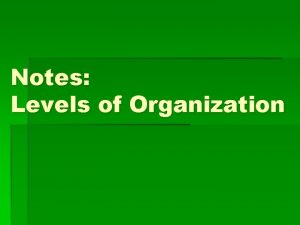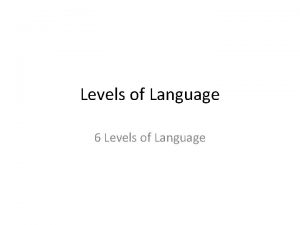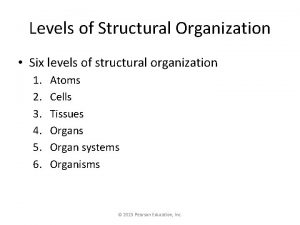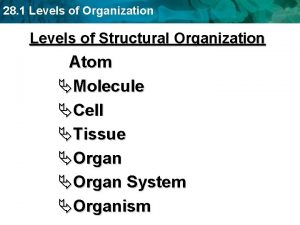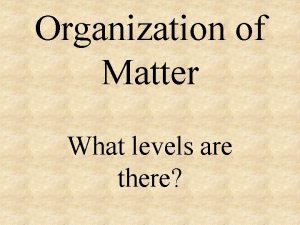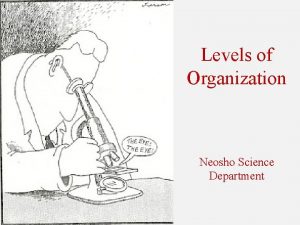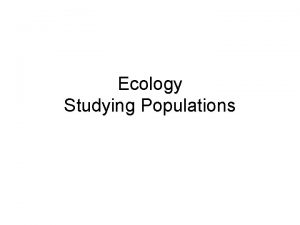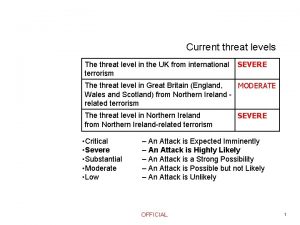Levels of Organization Match the Level of Organization





















- Slides: 21

Levels of Organization

Match the Level of Organization with the correct example… Level of Organization: Examples: ORGANISM BIOME COMMUNITY POPULATION BIOSPHERE ECOSYSTEM EARTH FRESHMEN CLASS JOE CHARGER DECIDIOUS FOREST WESTCHESTER, IL ST. JOSEPH HIGH SCHOOL

Match the Level of Organization with the correct example… Level of Organization: 1 ORGANISM 5 BIOME 3 COMMUNITY 2 POPULATION 6 BIOSPHERE 4 ECOSYSTEM Examples: EARTH FRESHMEN CLASS JOE CHARGER DECIDIOUS FOREST WESTCHESTER, IL ST. JOSEPH HIGH SCHOOL

Ecology Book Chapters 3 &4

What is Ecology? • Ecology is the study of relationships between organisms and their environment • Interactions between organisms in the same environment

Energy Flow • Energy is constantly flowing through ecosystems • Energy always starts with the sun! • The sun is the main source of energy for life on Earth!

Producers and Consumers • Autotrophs use energy from the environment to make their own food • Also called producers • Heterotrophs rely on other organisms for their energy and food supply • Also called consumers

What kind of Consumer? • Carnivore? • Herbivore? • Omnivore? • Detritivore?

Feeding Relationships • Energy flows through an ecosystem in one direction, from the sun to producers to consumers • A food chain shows some of the feeding relationships in an ecosystem

Producer: Use the sun to make food Primary (1 o) Consumer: Consume producers Secondary (2 o) Consumer: Consume primary consumers Tertiary (3 o) Consumer: Consume secondary consumers

Extra Consumers • Sometimes there are consumers beyond the tertiary consumer • Called the quaternary consumer

What is the… • Tertiary Consumer? • Primary Consumer? • Producer? • Secondary Consumer? • Quaternary Consumer?

Food Webs https: //i. ytimg. com/an_webp/b. W 7 Pl. Taawf Q/mqdefault_6 s. webp? du=3000&sqp=CJD 6 _OUF&rs=AOn 4 CLA_3 HCm 1 n. UOGf. UZGkxr. Hl ze. Mh. Ku. Pw • When the feeding relationships among the various organisms in an ecosystem form a network of complex interactions, these relationships are called food webs • Food webs link all the food chains in an ecosystem

What role in the food web? • Mountain lion? • Tertiary • Ringtail? • Secondary

Trophic Levels • Each step of a food chain or food web is called a trophic level • Producers ALWAYS make up the first trophic level • Consumers make up the higher trophic levels

Ecological Pyramid • The amount of energy present in each trophic level is different • The higher up the food chain, the less and less energy is present • To show the relative amounts of energy within each level of a food chain or web, ecological pyramids are used

Organisms at the bottom of the pyramid have the most biomass

10% Rule • Each trophic level receives about 10% of the energy from the level below it • Where does the energy go? • Movement • Body Heat • Daily Functions

0. 1% 1% 100% If the grass receives 1500 k. J of energy, how much energy do the beetles receive? 150 k. J Timon & Pumbaa? 15 k. J Scar? 1. 5 k. J

1 a. What is doing the eating/The flow of energy in a food chain 1 b. Lettuce Cat 1 c. Ladybug Fox 1 d. Thrush 1 e. The sun Thrush Slug Rabbit 2 b. Grass 2 c. Slug/Thursh/Fox/Rabbit/Cat 2 d. Fox/Cat 2 e. Rabbit/Slug

3 a. Land plant/Tiny water plants 3 b. Anything other than the plants 3 c. Water plants Water fleas Diving beetle Small fish Perch Heron 3 d. Diving beetle/Water flea 3 e. Heron/Perch 3 f. Fox and heron decrease/slug, insect, beetle increase/land plant decrease 4. Food webs show all the food chains in an ecosystem. They provide a more complete picture of how energy is flowing in an ecosystem.
 Level 2 questions examples
Level 2 questions examples Match each graph with the correct description.
Match each graph with the correct description. Unit 9 human body systems review
Unit 9 human body systems review Levels of organization atom
Levels of organization atom 6 levels of organization
6 levels of organization Plant organization levels
Plant organization levels Levels of biological organization
Levels of biological organization K strategist curve
K strategist curve How are herbivores and carnivores alike
How are herbivores and carnivores alike Smallest part of the plant
Smallest part of the plant Levels of organization in an ecosystem
Levels of organization in an ecosystem Chapter 3 lesson 1 introduction to global systems
Chapter 3 lesson 1 introduction to global systems 5 levels of organization
5 levels of organization Levels of biological organization from smallest to largest
Levels of biological organization from smallest to largest Community in desert
Community in desert Levels of organization in ecosystem
Levels of organization in ecosystem Level of ecosystem
Level of ecosystem Organisms ecology
Organisms ecology Density independent factor
Density independent factor Producers
Producers Levels of organization in the biosphere
Levels of organization in the biosphere Rules in binomial nomenclature
Rules in binomial nomenclature

